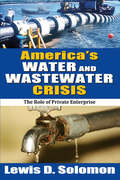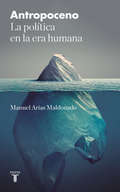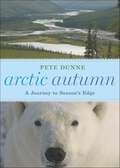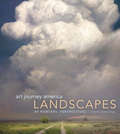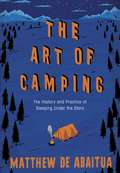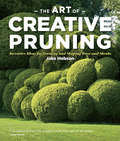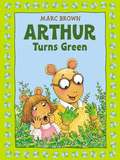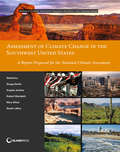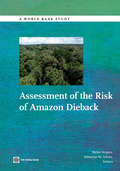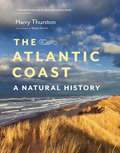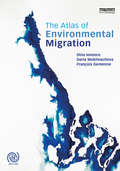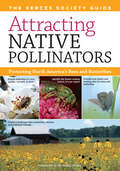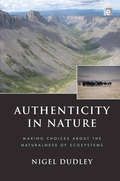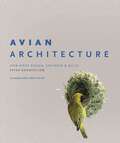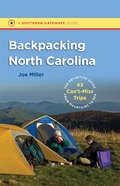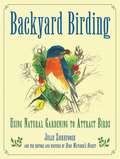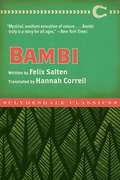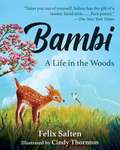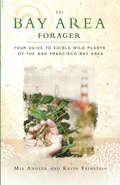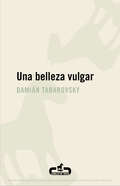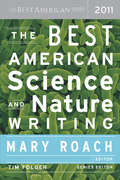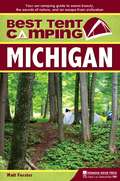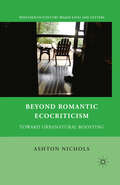- Table View
- List View
America's Water and Wastewater Crisis: The Role of Private Enterprise
by Lewis D. SolomonThis book examines the role of private firms in the American water and wastewater industry. As more water infrastructure shifts from public- to private-sector control, vendors, consultants, and facilities are taking on more importance. Lewis D. Solomon presents an historical overview of water supply and treatment needs and the role of the government, including how water policy has been crafted. He argues that water scarcity is becoming a problem due to groundwater depletion, contamination, and patterns of consumption. He examines the impact of climate change on water availability and quality considering voluntary conservation programs and mandatory restrictions for water use.Solomon points to how for-profit firms can use technology to increase water supply. He describes what privatization would look like in practice and reviews evidence from two case studies. Solomon proposes privatization as a viable response to America's water crisis that can address both scarcity and capital problems.America's Water and Wastewater Crisis presents a careful examination of how the water industry has operated in the United States in the past and how it may work as we move into the future. This book is invaluable to environmental specialists, businessmen, and government officials.
Antropoceno: La política en la era humana
by Manuel Arias MaldonadoEl Antropoceno es una nueva época geológica cuyo rasgo central es el protagonismo de la humanidad, convertida en agente de cambio medioambiental a escala planetaria. Desde una postura original, elegante y sensata, Arias Maldonado aprovecha todas las oportunidades que ofrece el concepto, un excelente marco teórico para el debate sobre la sostenibilidad global, la conservación de las formas y espacios naturales, así como para la moralización de las relaciones entre el ser humano y la naturaleza. La colonización humana del planeta ha terminado por conducirnos a una nueva época geológica: el Antropoceno. Al menos, así lo indica una sólida hipótesis científica según la cual el progresivo acoplamiento de los sistemas sociales y naturales ha hecho de la humanidad el principal agente de cambio medioambiental global. De manera que el Holoceno, bajo cuyas benévolas condiciones climáticas ha prosperado la humanidad, está dejando paso a un nuevo régimen planetario lleno de peligros y oportunidades. Del cambio climático a la extinción de especies, de la urbanización a la reforestación, el Antropoceno es un fenómeno ambiguo: un efecto colateral del progreso humano que despierta a las fuerzas telúricas que operan en el tiempo profundo y nos recuerda que somos criaturas terrenales. En este libro de vocación interdisciplinar, Manuel Arias Maldonado somete a riguroso análisis este novísimo concepto y se pregunta por sus consecuencias políticas. O sea: por los efectos que para la sociedad liberal y la democracia tiene una mutación planetaria que obliga a reorganizar las relaciones socionaturales.
Arctic Autumn: A Journey to Season's Edge
by Pete DunneThe Arctic doesn't spring to mind when most people think about autumn. Yet in his continuing effort to invite readers' curiosity through unpredictability, Pete Dunne pairs the transitional season of autumn with this fragile environment in flux. The book begins on Bylot Island in Nunavut, Canada, at the retreating edge of the seasonal ice sheet, then moves to Alaska, where the needs of molting geese go head to head with society's need for oil. Then on to the Barren Lands of Canada and a search for the celebrated caribou herds that mean life and death for human and animal predators alike. A canoe trip down the John River is filled with memories, laughter, and contemplation. A caribou hunt with a professional trapper leads to a polemic on hunting. Dunne travels to an island in the Bering Sea, off the coast of Alaska, to look for rare birds and ponder the passionate nature of competitive bird listers. No trip to the Arctic would be complete without a trip to see polar bears, so Dunne and his wife visit Churchill, Manitoba, the polar bear capital of the world. These majestic but threatened creatures lead Dunne to think about his own life, our interactions with the natural world, and the importance of the Arctic, North America's last great wilderness.
Art Journey America Landscapes: 89 Painters' Perspectives (Art Journey)
by Kathy KippShowcasing the work of more than 100 top contemporary American master artists of our day, this book features landscapes (a popular subject for art collectors and a tradition throughout American art history) from all across the country-east and west, north and south-rendered in watercolor, oil, acrylic, pastel, colored pencil and mixed media. Accompanying each painting are the thoughts, techniques and inspirations for the paintings by each artist.
The Art of Camping: The History and Practice of Sleeping Under the Stars
by Matthew De AbaituaCould there be another way of life? Can I survive with less stuff? Should I run for the hills?These are all good questions that people have asked before, throughout history, and which have inspired people to set up camp. But now camping is part of the drive for self-sufficiency, a reaction against mass tourism, a chance to connect with the land, to experience a community, to leave no trace . . . From packing to pitching, with hikes into the deep history of the subject and encounters with the great campers and camping movements of the past, this is the only book you'll need to pack when you next head off to sleep under the stars.IF THERE IS ONE THING THAT CAMPERS LIKE MORE THAN CAMPING, IT'S DREAMING ABOUT THEIR NEXT TRIP
The Art of Creative Pruning: Inventive Ideas for Training and Shaping Trees and Shrubs
by Jake HobsonNothing brings a touch of artistry to the garden like ornamental pruning, and a series of deliberate cuts can create landscapes and evoke faraway places. All that's needed to recreate the effect in the garden are a sharp pair of pruners, some imagination, and the instruction found in The Art of Creative Pruning. Drawing on both eastern and western styles, author Jake Hobson moves beyond the traditional lollipops and animals and teaches a wholly new approach to ornamental pruning that appeals to modern sensibilities. Picture boxwoods trimmed into whimsical Russian nesting dolls, hedges inscribed with words, and a tree snipped to resemble the toppling tiers of a wedding cake. These are just a few of the unusual ideas featured in the beautifully photographed pages. All the practical considerations are here as well, including pruning to improve a view, remedial pruning to fix problems, and pruning fruit trees to increase yield.
Arthur Turns Green
by Marc BrownArthur is full of ideas when it comes to doing his part to save the planet. But is he actually turning green? Arthur comes home from school and begins sneaking around the house, taking notes and talking about a Big Green Machine. D.W. is suspicious of her brother's weird behavior, and when Arthur shows up late for dinner with green hands, she really gets the creeps! Will the Big Green Machine get her, too? Find out how Arthur's secret project convinces his entire family to turn green! Get to know your favorite aardvark all over again in the first new Arthur Adventure in nearly a decade!
Assessing the Requirements for Sustained Ocean Color Research and Operations
by Committee on the Assessment of Ongoing Efforts in the Treatment of Posttraumatic Stress DisorderThe ocean is a fundamental component of the earth's biosphere. It covers roughly 70 percent of Earth's surface and plays a pivotal role in the cycling of life's building blocks, such as nitrogen, carbon, oxygen, and sulfur. The ocean also contributes to regulating the climate system. Most of the primary producers in the ocean comprise of microscopic plants and some bacteria; and these photosynthetic organisms (phytoplankton) form the base of the ocean's food web. Monitoring the health of the ocean and its productivity is critical to understanding and managing the ocean's essential functions and living resources. Because the ocean is so vast and difficult for humans to explore, satellite remote sensing of ocean color is currently the only way to observe and monitor the biological state of the surface ocean globally on time scales of days to decades. Ocean color measurements reveal a wealth of ecologically important characteristics including: chlorophyll concentration, the rate of phytoplankton photosynthesis, sediment transport, dispersion of pollutants, and responses of oceanic biota to long-term climate changes. Continuity of satellite ocean color data and associated climate research products are presently at significant risk for the U.S. ocean color community. Assessing Requirements for Sustained Ocean Color Research and Operations aims to identify the ocean color data needs for a broad range of end users, develop a consensus for the minimum requirements, and outline options to meet these needs on a sustained basis. The report assesses lessons learned in global ocean color remote sensing from the SeaWiFS/MODIS era to guide planning for acquisition of future global ocean color radiance data to support U.S. research and operational needs.
Assessment of Climate Change in the Southwest United States: A Report Prepared for the National Climate Assessment (NCA Regional Input Reports)
by Gregg Garfin Mary Black Sarah Leroy Angela Jardine Robert MeridethPrepared for the 2013 National Climate Assessment and a landmark study in terms of its breadth and depth of coverage, this report blends the contributions of 120 experts in climate science, economics, ecology, engineering, geography, hydrology, planning, resources management, and other disciplines to provide the most comprehensive, and understandable, analysis to date about climate and its effects on the people and landscapes of Arizona, California, Colorado, Nevada, New Mexico, and Utah--including the U. S. -Mexico border region and the lands of Native Nations. What is the climate of the Southwest like today? What has it been like in the past, and how is it projected to change over the 21st century? How will that affect water resources, ecosystems, agricultural production, energy supply and delivery, transportation, human health, and a host of other areas? How vulnerable is the region to climate change? What else do we need to know about it, and how can we limit its adverse effects?In addressing these and other questions, the book offers decision makers and stakeholders a substantial basis from which to make informed choices that will affect the well-being of the region's inhabitants in the decades to come.
Assessment of the Risk of Amazon Dieback
by Sebastian M. Scholz Walter VergaraThe Amazon basin is a key component of the global carbon cycle. Not only is the old-growth rainforests in the basin huge carbon storage with about 120 billion metric tons of carbon in their biomass, but they also process annually twice the rate of global anthropogenic fossil fuel emissions through respiration and photosynthesis. In addition, the basin is the largest global repository of biodiversity and produces about 20 percent of the world's flow of fresh water into the oceans. Despite the large CO2 efflux from recent deforestation, the Amazon rainforest is still considered to be a net carbon sink or reservoir because vegetation growth on average exceeds mortality. However, current climate trends and human-induced deforestation may be transforming forest structure and behavior. Amazon forest dieback would be a massive event, affecting all life-forms that rely on this diverse ecosystem, including humans, and producing ramifications for the entire planet. Clearly, with changes at a global scale at stake, there is a need to better understand the risk, and dynamics of Amazon dieback. Therefore, the purpose of the book is to assist in understanding the risk, process and dynamics of potential Amazon dieback and its implications.
The Atlantic Coast
by Wayne Barrett Harry ThurstonThe North Atlantic coast of North America-commonly known as the Atlantic Coast-extends from Newfoundland and Labrador through the Maritime Provinces and the Northeastern United States south to Cape Hatteras. This North Atlantic region belongs to the sea. The maritime influence on climate, flora, and fauna is dominant - even far inland. Both on land and at sea, this region is where north meets south, where the great northern boreal forests intermingle with the southern coniferous-hardwood forests, and where the icy Labrador Current and the tropical Gulf Stream vie for supremacy and eventually mix. The Atlantic Coast draws upon the best and most up-to-date science on the ecology of the region as well as the author's lifetime experience as a resident, biologist, and naturalist. The book explores the geological origins of the region, the two major forest realms, and the main freshwater and marine ecosystems, and describes the flora and fauna that characterize each habitat. It ends with a look at what has been lost and how the remaining natural heritage of the region might be conserved for the future.
The Atlas of Environmental Migration
by Dina Ionesco Daria Mokhnacheva François GemenneAs climate change and extreme weather events increasingly threaten traditional landscapes and livelihoods of entire communities the need to study its impact on human migration and population displacement has never been greater. The Atlas of Environmental Migration is the first illustrated publication mapping this complex phenomenon. It clarifies terminology and concepts, draws a typology of migration related to environment and climate change, describes the multiple factors at play, explains the challenges, and highlights the opportunities related to this phenomenon. Through elaborate maps, diagrams, illustrations, case studies from all over the world based on the most updated international research findings, the Atlas guides the reader from the roots of environmental migration through to governance. In addition to the primary audience of students and scholars of environment studies, climate change, geography and migration it will also be of interest to researchers and students in politics, economics and international relations departments.
Attracting Native Pollinators: The Xerces Society Guide to Conserving North American Bees and Butterflies and Their Habitat
by The Xerces Society Dr Marla SpivakWith the recent decline of the European honey bee, it is more important than ever to encourage the activity of other native pollinators to keep your flowers beautiful and your grains and produce plentiful. In Attracting Native Pollinators, you’ll find ideas for building nesting structures and creating a welcoming habitat for an array of diverse pollinators that includes not only bees, but butterflies, moths, and more. Take action and protect North America’s food supply for the future, while at the same time enjoying a happily bustling landscape.
Authenticity in Nature: Making Choices about the Naturalness of Ecosystems
by Nigel DudleyThis book examines the concept of naturalness in ecosystems, discusses its values and considers choices about the level of naturalness in conservation efforts. The author argues that all ecosystems have been modified and the idea of places 'untouched by humans' is a myth. But there are large differences in the degree of modification and levels of naturalness which can be identified. Changes are not always irreversible; some apparent wilderness areas are sites of former civilizations. There is no longer any simple distinction possible between 'natural' and 'cultural' systems. In the future, society will, to some extent, choose the degree of naturalness in land and seascapes. The growth of protected areas is an early sign of this, as are changes in forest management, dam removal and control of invasive species. To make informed choices about these areas, the author shows that we must understand the characteristics and values of naturally regulating ecosystems – their practical benefits, social values and management needs. Authenticity in Nature uses a rigorous definition of authenticity to help in the understanding and measurement of naturalness. It discusses the choices facing us and some of the information we need to make decisions relating to land and water management. Practical issues of management and numerous terrestrial and aquatic examples from around the world are discussed. It is an optimistic and highly original book, aiming to make genuine advances in our understanding and management of natural systems.
Avian Architecture: How Birds Design, Engineer, and Build
by Peter GoodfellowAn illustrated guide to how birds design and build their nestsBirds are the most consistently inventive builders, and their nests set the bar for functional design in nature. Avian Architecture describes how birds design, engineer, and build their nests, deconstructing all types of nests found around the world using architectural blueprints and detailed descriptions of the construction processes and engineering techniques birds use. This spectacularly illustrated book features 300 full-color images and more than 35 case studies that profile key species worldwide. Each chapter covers a different type of nest, from tunnel nests and mound nests to floating nests, hanging nests, woven nests, and even multiple-nest avian cities. Other kinds of avian construction—such as bowers and harvest wells—are also featured.Avian Architecture includes intricate step-by-step sequences, visual spreads on nest-building materials and methods, and insightful commentary by a leading expert.Illustrates how birds around the world design, engineer, and build their nestsFeatures architectural blueprints, step-by-step sequences, visual spreads on nest-building materials and methods, and expert commentaryIncludes 300 full-color imagesCovers more than 100 bird species worldwide
Backpacking North Carolina
by Joe MillerJoe Miller brings us the first-ever stand-alone guidebook to backpacking in North Carolina, a state long known as a terrific backpacking destination. Covering 43 of the best trips the state has to offer,Backpacking North Carolinaprovides all the information necessary for beginning and experienced backpackers alike to enjoy hiking destinations from the mountains to the coast. Each trip description offers key maps and navigation information, including water sources and camping spots, as well as trip highlights and special considerations. Miller offers tips for enriching the experience, such as filling dark nights with stargazing and other activities, and gives advice for backpacking with children. Offering his expertise in a way that emphasizes the accessibility of backpacking, Miller encourages a wide range of nature lovers to give it a try, perhaps for the first time. Several "best-of" lists are included, featuring trips with exceptional nature study opportunities, water recreation, and easy excursions for beginners. Backpacking North Carolinatakes the reader deep into a state full of natural wonder and adventure. Backpacking North Carolinahas all the essentials for planning your trip, whether a quick weekend getaway or a longer adventure: "Trips for beginner and expert backpackers alike "Helpful essays to introduce each trail and its features "Gear and safety advice for year-round backpacking "Major points of interest highlighted on each trip "Family-friendly trails and easy bailouts for when hiking with children "Detailed trail maps and directions to trailheads "Elevation profiles for each hike "Estimated hike times and level of difficulty "Camping permit requirements "GPS coordinates for water sources and good camping spots "Bullet lists of best trips for fishing, bird watching, waterfalls, and more
Backyard Birding: Using Natural Gardening to Attract Birds (Rodale Organic Gardening Book Ser.)
by Julie ZickefooseBird watchers everywhere dream of a landscape filled with berry-laden branches, nesting spots among twining vines, and birds crowding their feeding stations. Let "Backyard Birding" show you how to lay out the welcome mat for your feathered friends by considering all of their needs, including year-round water, food, and shelter. Whether youOCOre looking to create a hummingbird garden, install a water feature, create perches for birds, or simply let a corner of your property run wild, youOCOll find all of the inspiration and information you need here in "Backyard Birding. ""
Bambi: A Life In The Woods (Clydesdale Classics #Vol. 146)
by Felix SaltenMost nineties kids grew up with the adorable Disney movie Bambi, but the basis for the movie was the 1923 book by Felix Salten. In this stunning edition, experience the classic story brought to life again! The original story of young Bambi starts as he begins life in the forest with his mother, cousins, and other furry friends. However, as winter spreads it icy hands over the forest, Bambi’s father, a powerful stag, leaves Bambi and his mother alone to brave the elements and scavenge for food. Bambi also faces the threat of Man, along with Man’s weapons that can hurt and kill any animal. Though Bambi fears for his life and the well-being of his friends and family, nothing, not even Man, can stop him from growing to become a mighty Prince of the Forest. With the beautiful refurbished text and illustrations, adults and children of all ages can enjoy this new edition of Bambi.
Bambi: A Life in the Woods (Clydesdale Classics Ser. #Vol. 146)
by Felix SaltenA beautiful, newly-illustrated edition of the original classic Most 90s kids grew up with the adorable Disney movie Bambi, but did you know it was originally a book? Now the classic 1923 novel about the life of a young deer is getting a new edition filled with beautiful, full-color illustrations! The original story of young Bambi starts as he begins life in the forest with his mother, cousins, and other furry friends. However, as winter spreads it icy hands over the forest, Bambi&’s father, a powerful stag, leaves Bambi and his mother alone to brave the elements and scavenge for food. Bambi also faces the threat of Man, along with Man&’s weapons that can hurt and kill any animal. Though Bambi fears for his life and the well-being of his friends and family, nothing, not even Man, can stop him from growing to become a mighty Prince of the Forest. With the beautiful refurbished text and illustrations, adults and children of all ages can enjoy this new edition of the original Bambi.
The Bay Area Forager: Your Guide to Edible Wild Plants of the San Francisco Bay Area
by Mia Andler Kevin FeinsteinReading this guidebook is like taking a wild foods walk with foraging experts Mia Andler and Kevin Feinstein: it gives practical advice for gathering edible wild plants in the Bay Area in a voice that is friendly and suffused with rich personal knowledge. The authors provide thorough descriptions of where to find each of the region's most readily available plants, and they give clear instructions for harvesting them responsibly. Large, detailed photographs help readers to identify plants easily. Also included are mouth-watering recipes such as cattail crêpes, cherry laurel cordial, fiddlehead fusilli, and rosehip soup. Ideal for any experience level, The Bay Area Forager invites readers to deepen their relationship with their environment.
Una belleza vuglar
by Damián TabarovskyUna hoja se desprende de un árbol en una calle concreta de Buenos Aires. Mientras cae y como si la hoja funcionase como un espejo de almas y cuerpos, la narración da cuenta de los habitantes de un edificio: sus expectativas, su realidad, sus sueños, sus deseos... hasta componer un retrato poliédrico de las formas de vida de nuestro tiempo. La narración se presenta así como un intento de gran originalidad que busca atrapar «esa belleza que todavía no ha llegado al mundo», que flota sobre nosotros y que en pocas ocasiones nos atrevemos a reconocer.«Hay que defender esta literatura, y la de Damián Tabarovsky lo es en grado sumo, si queremos evitar que los aduladores de la vacuidad acampen a su antojo.»Ernesto Ayala, Babelia
The Best American Science and Nature Writing 2011: The Best American Series (The Best American Series)
by Mary RoachThe New York Times–bestselling author of Packing for Mars presents fascinating essays by Jonathan Lethem, Jaron Lanier, Malcom Gladwell and others.Good science writing, as Mary Roach explains in her introduction, is a cure for ignorance and fallacy. But great science writing adds honey—in the form of engaging characters, stories, and wit—to make the medicine go down. This anthology reveals the essential humanity in our endless quest for knowledge and understanding.From a study of avian mating habits with unintended political implications to a sober exploration of the panic surrounding artificial intelligence, The Best Science and Nature Writing 2011 offers food for thought in a variety of flavors.The Best Science and Nature Writing 2011 includes entries by Deborah Blum, Burkhard Bilger, Ian Frazier, David H. Freedman, Atul Gawande, Stephen Hawking, Christopher Ketcham, Jill Sisson Quinn, Oliver Sachs, and others.
Best Tent Camping: Michigan
by Matt ForsterWritten to steer campers away from concrete slabs and convoys of RVs, Best Tent Camping: Michigan points tent campers to the most scenic and serene campsites in the state. This guide has a campground to suit nearly every camper's taste. You'll find essential information about each campground (including season, facilities, rates, directions, GPS coordinates, and Web sites), as well as a description of the campground, the best sites, and nearby activities such as hiking, canoeing, fishing, and mountain biking.
Beyond Romantic Ecocriticism: Toward Urbanatural Roosting (Nineteenth-Century Major Lives and Letters)
by Ashton NicholsNichols chronicles the Enlightenment view of 'Nature' as static and separate from humans as it moved towards the Romantic 'nature' characterized by dynamic links among all living things. Engaging Romantic and Victorian thinkers, as well as contemporary scholarship, he draws new conclusions about 21st-century ideas of nature.
